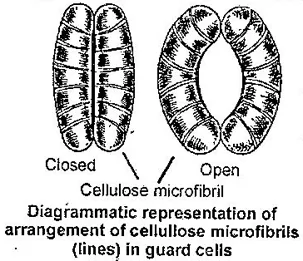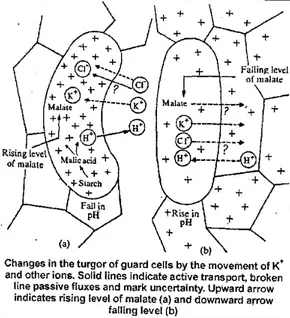Explain the Mechanism of Stomatal Opening.
The Mechanism of Stomatal Opening.
The opening and closing of the water-loosing stomata is regulated by guard cells that, in turn, are regulated by uptake of potassium ions. As guard cells change shape, stomata open and close. Greater bowing of the guard cells during turgor increases the size of the stoma opening. As surrounding cells become flaccid, bowing decreases and the stoma closes.
Due to radial orientation of micro-fibrils in the guard cells, the guard cell length increases more than its width during turgor. Changes in guard cell turgor are regulated by the passage of potassium ions across the plasma and vacuolar membranes. This is assisted by the uptake of anions, such as malate and chloride.

It is important to remember certain points:
- Normally, stomata are open in the day and are closed at night. But even a drop of can leads to the day time closure of stomata.
- Decrease in the internal concentration of CO2 leads the opening of stomata, while its maximum concentration close the stomata.
- Dark CO2 fixation occurs in the guard cells.
- There is a change of pH in guard cells during day and night due to inter-conversion of starch and sugar.
- Stomata open when guard cells actively accumulate potassium ions from neighboring epidermal cells due to proton pump-generated membrane potential.
- Active transport of hydrogen ions out of guard cells is correlated with stomatal opening.
- Absorption of potassium ions decreases water potential within guard cells, causing the opening of stomata. When K+ ions are lost from guard cells, osmosis causes water loss to surrounding cells and stomata close.
- Inhibitors of cyclic phosphorylation can also close stomata.
- Blue light causes opening of stomata.
- At very low concentration Abscisic acid can lead to the closure of stomata.
Stomata open when guard cells take up water, leading the cells to bow outward (e.g., kidney bean shape). When the cells lose Water, they become more flaccid and collapse inward, thus decreasing the size of the opening. Guard cells open due to an uptake of potassium ions (K+). The concentration of K+ in open guard cells far exceeds that in the surrounding cells.
The K+ is accumulated in the guard cells from neighboring cells. The K+ moves across the guard plasma membrane through membrane potential that is brought about by proton pumps. To take up water (and for stomata to open), the guard cells actively pump out H+, resulting in a membrane potential that allows to enter the cell.
As the K+ accumulates in the guard cell, the water potential in ide the cell decreases, resulting in the movement of water into the cell through osmosis. The increased water results in more turgid cells, causing the cells to bow outward. When water and K+ enter the guard cell they are stored within the cell’s vacuoles. When the K+ ions move back out of the cell, water also moves out, causing the cells to become more flaccid. When this occurs, the guard cells lose their bowed structure, closing the stomata opening.



